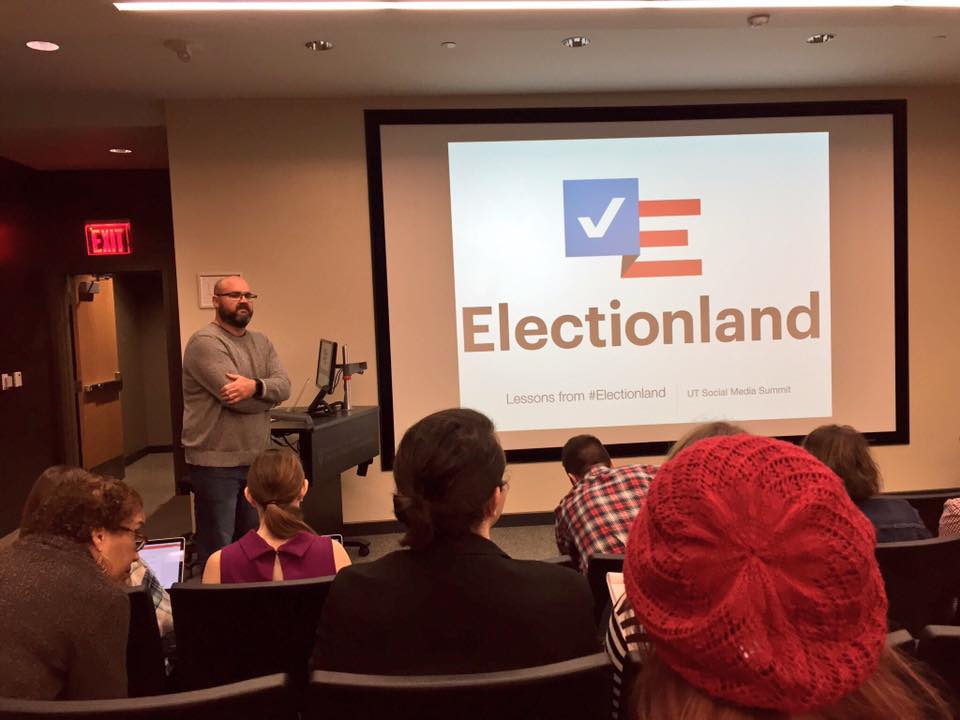Texas State University MILab: introducing media innovation into university teaching
Through their work with Web development, virtual reality/360 video, drone journalism and multimedia storytelling, the team is looking to influence digital media disciplines and research the constant evolution of the media industry.
Located in San Marcos, Texas State University’s Media Innovation Lab (MILab) in the School of Journalism and Mass Communication) focuses on introducing media innovation into the academic curriculum. The digital research lab was officially started in 2016 with the opening of a lab classroom, student lab and maker space.
However, the lab’s activity goes back more than a decade, during which time the team, led by Cindy Royal, director of the Texas State University Media Innovation Lab, has developed innovative courses, conducted research on digital innovation and created innovation projects.
The lab features a maker space that offers assistance to students, faculty members and others with a project idea, as well as a classroom where students attend various digital media innovation courses. It also serves as a regular meeting spot for the Digital Media team and other university organisations to arrange collaborations between faculty members and students on various projects.
Meaningful for the profession
Texas State University’s MILab focuses primarily on academic research and influencing undergraduate and postgraduate digital media teaching. Director of the Media Innovation Lab Cindy Royal believes academic research and evolution of university media courses to be the foundation to a better understanding of the current media environment:
“A lot of the things that we’re making are in the structure of courses. We’re instructing students right now in hopes that they’re creating things that will improve their portfolio, things that we can submit to competitions, and then maybe eventually out of that something viable from a business perspective will come out of it,” she explains.

The team combines traditional approaches to academic research, using surveys, experiments and content analyses, with ethnography and qualitative, thematic analysis to explore new methods associated with media innovation. The MILab’s work has been published in Nieman Journalism Lab the International Symposium on Online Journalism and Mediashift:
“We’re trying to be innovative in the way we think about research, as well and try to do research that’s meaningful to the profession, as opposed to doing just what we think will get published,” Royal says.
ElectionLand project with ProPublica
One of the biggest projects completed by MILab was launching the Digital Media Innovation undergraduate degree, which was approved in August 2016 and which currently has 113 students enrolled.
Other projects include a collaboration with ProPublica for the ElectionLand event, where the Media Innovation Lab and university students were in charge of monitoring election improprieties through social media and detecting any issues arising, as well as the AEJMC (Association for Education in Journalism and Mass Communication) pre-conference on bringing digital into the university curriculum, which will be held in Chicago in August 2017.

As the lab’s primary focus is developing and evolving the academic curriculum, the Media Innovation Lab’s projects also include a variety of courses focused on digital technologies. By experimenting with different formats, the MILab can quickly introduce cutting-edge topics. Students can take short courses in virtual reality, 360 digital filming, coding and mobile application development, but can also opt for a longer-format, immersive, summer coding bootcamp.
Eager to collaborate
The Media Innovation Lab collaborates with local media and state organisations to offer students a variety of opportunities to learn more about digital innovation. Some of the partners include the Hacks/Hackers organisation, Texas Parks and Wildlife and the Meadows Centre for Water and the Environment at Texas State. They also work with South by Southwest, where students get to attend and cover the event and learn about the production of the large-scale festival.
The Media Innovation Lab is keen to continue their current endeavours of staying up-to-date with digital innovation. Cindy Royal adds the lab is looking forward to continuing to tailor and improve their academic courses over the next years, as well as continuing to publish academic research and develop innovation projects.
The team is also eager to enlarge their network and collaborate with new partners and staff members on any potential projects that are in line with the lab’s goals. The MILab recently received a grant from the university for virtual reality, 360 video, live streaming and drone equipment to improve their ability to tell stories about parks and the outdoors.
In addition to this, MILab is currently participating on the committee developing the Digital Media certification from the ACEJMC (Accrediting Council on Education in Journalism and Mass Communication. Moreover, the lab is working on a PhD training bootcamp to improve teaching in digital media studies.
CONTACT POINT

Cindy Royal, Director, Texas State University Media Innovation Lab
Web: http://www.masscomm.txstate.edu/media-innovation.html
Twitter: @CindyRoyal
